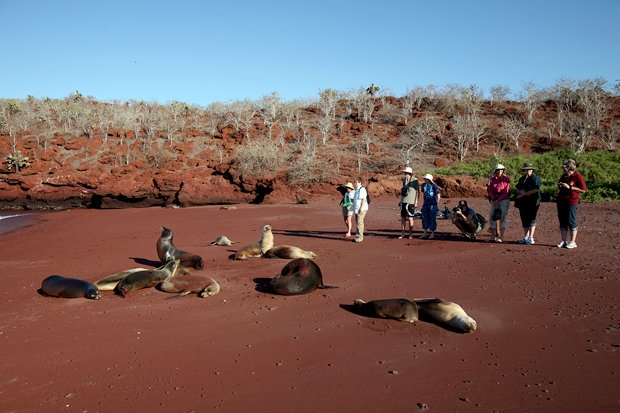Galapagos: ultimate nature adventure day 2

Day 2. The Galápagos are a largely untouched natural paradise, finds AG editor Ian Connellan.
IN THE WEE SMALL hours of the morning the San Jose motors from Santa Cruz to the eastern end of Isla Santiago, and James Bay. Early risers are treated to views of one of the youngest Galápagos islands, 4588 sq. km, 700,000 year old
Isabela – and its cloud-shrouded high point, 1646 m Vulcan Wolf.
After breakfast we head ashore for a two-hour walk (while San Jose’s crew, surprisingly well-kitted out, take on another cruise boat’s crew at a game of football). We’re barely ashore when we see a pair of Galápagos hawks, only about 85-90 of which inhabit Santiago. “On this side of the island the hawk is polyandrous – females have multiple partners and the males raise the chicks,” says Roberto.
It’s our first time with Galápagos lava sand underfoot and our first close-up look at some of the desert island plants, including the palo santo – holy stick – tree, which goes leafless and dormant in the dry season, prickly pear cactus and one of the four Acacia species found here – endemic distant relatives of wattle, and with more than a passing resemblance. “Most endemic flowers in the Galápagos are yellow or white, probably because they’re the most effective colours for attracting pollinators,” says Roberto.
We make our way along a shoreline decorated with marine iguanas – massed in places – and Sally Lightfoot crabs. We see both Galápagos sea lions and Galápagos fur seals and get a brief tutorial on telling them apart (size and nose shape, mainly).
LAUNCH THE GALLERY
Then it’s back to the San Jose to grab fins and masks for out first snorkelling excursion, which turns out to include green turtles feeding, schools of Galápagos fishes and – joy! – a young Galápagos sea lion, who plays inquisitively around us before a mate joins in for a spot of sea-lionish rough and tumble (which fortunately doesn’t include us).
After lunch we motor to Isla Rabida to see a vastly different beachscape – the eroding red of massed layers of volcanic ash.
A beefy male sea-lion “beachmaster” patrols, barking, offshore as we check his harem. Another snorkel (for some) and beach-walk (for others) later we’re back aboard San Jose, which motors off for Isla Bartolomé while we take showers, enjoy end-of-day drinks, gather for Roberto’s evening briefing and down another tasty dinner.
Only the crew is awake past 9pm; we’re a boatload of tired and happy expeditioners.
Read more blogs in the Galápagos series
Find out more about the next Peregrine/AG trip with Ian Connellan to
see Borneo’s
orangutans.

